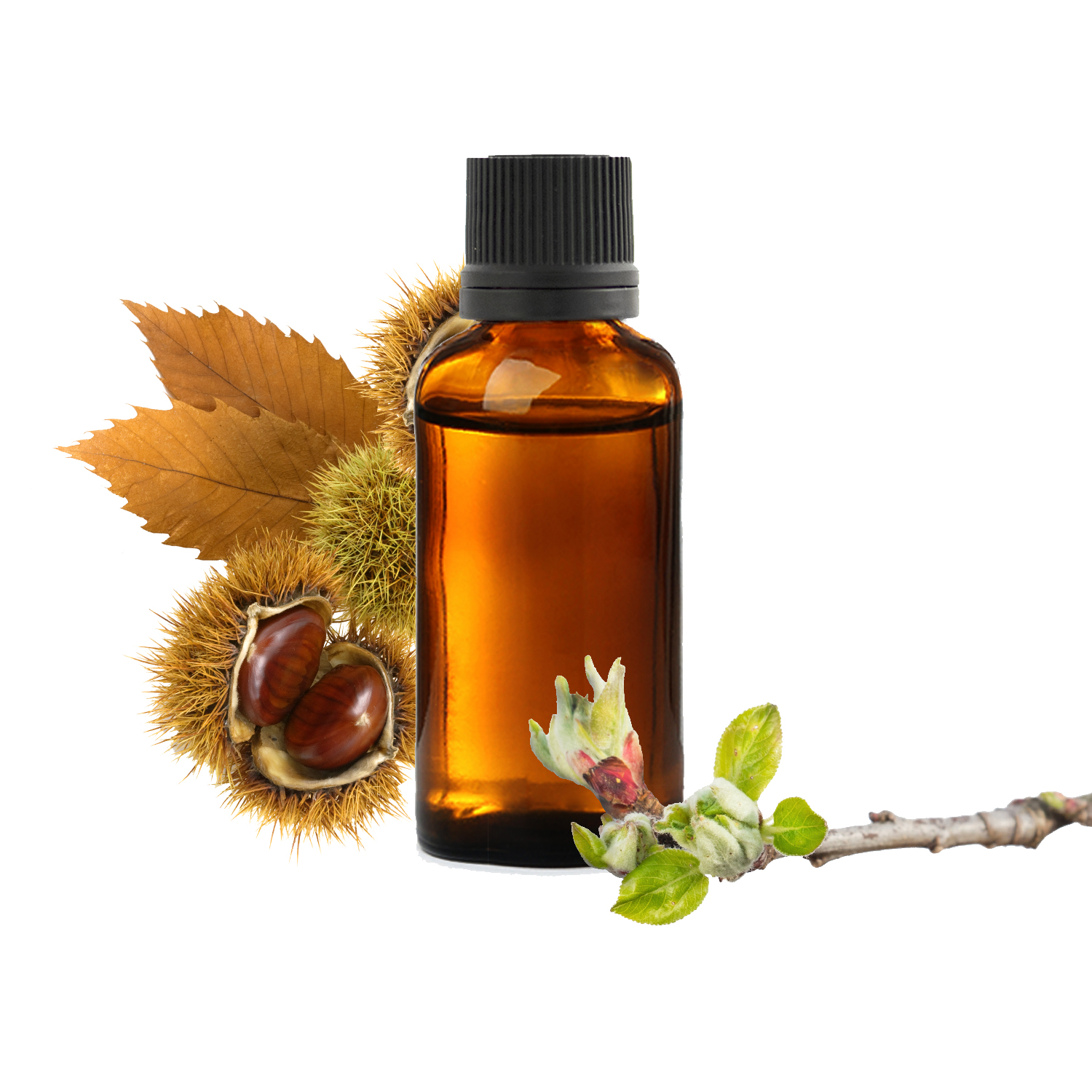
Chestnut bud macerate is appreciated for its qualities as a drainer of the lymphatic system, reducing edema and cellulite. It also has a role in protecting venous circulation in the lower limbs involved in the phenomena of varicose veins and associated ulcers. Chestnut bud macerate will be very suitable for situations of varicose veins, edema, heavy legs and peri-ulcerative eczema. Latin name: Castanea sativa Mill. Part used: Fresh buds
This article was updated on 19/07/2023For what problems should it be used?
-
Blood and lymphatic system ++++ : Varicose ulcer, Cellulite, Hemorrhoids, Heavy legs, Edema, Phlebitis, Fluid retention, Raynaud's syndrome, Varicose veins
-
Metabolic system +++ : Poisoning
-
Cutaneous system ++ : Eczema
How to use it alone?
Adults and adolescents : 5 to 15 drops per day in a glass of water, divided into 1 to 3 doses during the day depending on the case, 15 minutes before a meal for 3 weeks. Start with 5 drops and increase gradually:
- or one drop per day up to 15,
- i.e. 5 drops the first week, 10 the second and 15 the last.
Children over 3 years old : 1 drop per day for 10 kilos. Start with 1 drop and gradually increase.
Synergistic uses
Heavy legs
To act on heavy legs, you need to relieve congestion and promote better circulation. For this, the chestnut bud macerate is combined with the bud macerates of Chestnut tree and of Mountain ash, all complementary.
Varicose veins
Chestnut can be supplemented with Mountain ash to smooth circulation, and repair and tone the vein walls. THE Dogwood Sanguine where the Lemon can also be interesting as a supplement.
Hemorrhoids
Macerates of chestnut buds, Chestnut tree and of Mountain ash can be combined in cases of hemorrhoids. They help improve blood and lymphatic circulation, tone it and, above all, make it more fluid to avoid these inconveniences.
Dysmenorrhea
For its decongestant action in the pelvic region, chestnut bud macerate can be used in cases of dysmenorrhea. It can be associated with Raspberry bush to act on hormonal rebalancing.
Main properties
-
lymphatic draining :
chestnut is the bud macerate par excellence for toning lymphatic tissue and draining lymph. This allows it to cleanse it of its toxins, particularly certain chemicals, and to fight against self-intoxication. Chestnut bud macerate is particularly indicated in congestive phenomena and circulatory stasis, specifically of the lower limbs even if it also acts on the upper limbs. Lymphatic overload can further weaken nerve tissues, causing nerve spasms or pain. Chestnut therefore acts indirectly on the nervous system.
-
venous tonic :
chestnut bud macerate also acts on blood circulation by toning the vein wall. This action is perfectly complementary with its lymphatic effect: if the blood system is sluggish, the drainage of toxins may be less effective. By acting on both blood and lymphatic circulation, bud macerate therefore allows effective drainage of the body and deep tissues.
Precautions for use
- Chestnut bud macerate is a herbal food supplement. It does not replace a varied diet and a healthy lifestyle. It is important to keep it out of the reach of children and not to exceed the recommended daily dose. Dosages must be adapted for young children.
- Chestnut bud macerate is authorized for the whole family, except for babies under 3 years old and pregnant women.
- Store away from light and heat.
What does a good Chestnut bud macerate look like?
Botanical characteristics
- Latin name: Castanea sativa Mill.
- Botanical family: Fagaceae
- Distilled part: fresh buds
Composition
- Composition: Alcohol* 32%, Water, Chestnut bud extract (Castanea sativa Mill.)*.
Organoleptic characteristics
- Appearance: liquid - possible cloudiness
- Color: orange brown, reddish brown
- Odor: woody, slightly alcoholic.
- Taste: sweet, alcoholic.
Was this article helpful to you?
Average grade: 4.8 ( 510 votes)
Bibliography
Work : Piterà di Clima, F., & Nicoletti, M. (2018). Summary of gemmotherapy - Scientific foundations of Meristemotherapy. Amyris Editions.
Work : Boistard, S. (2016). Gemmotherapy - Buds for health - Practical and family guide. Terran Publishing.
Work : Andrianne, P. (2011). Treatise on gemmotherapy: Therapy using buds. Amyris Editions.
Work : Halfon, R. (2011). Gemmotherapy - Health through buds. Dangles Editions.
Work : Ledoux, F., & Guéniot, G. (2014). Phytembryotherapy: The embryo of gemmotherapy. Amyris Editions.
Work : Pineau, L. (2019). The great book of gemmotherapy. Leduc.s Éditions.


